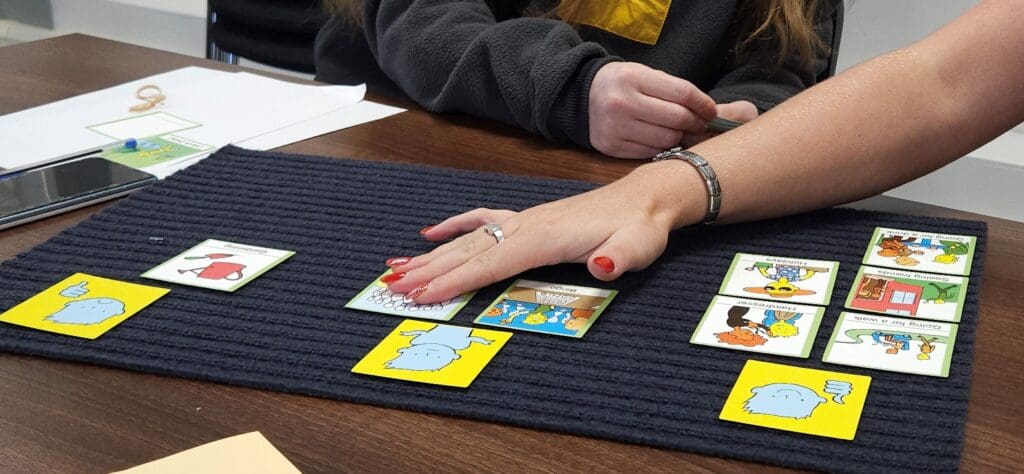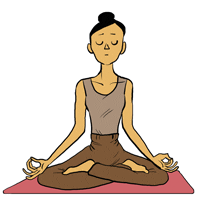
Introducing Claire Neaves
After many years as a Licenced Trainer we are delighted that Claire has joined the Talking Mats team as a Consultant. In this blog Claire gives us an insight into her other passion and reflects on similarities between her yoga practise and Talking Mats.
A Tale of Two Mats: Synergy and learning from the yoga mat to a Talking Mat.


What can the philosophy and practice of yoga teach us about our approach to carrying out a Talking Mat? Claire delves deeper into the key learnings from yoga and how the yoga mat can inspire our approach to Talking Mats.
Until last year, I was the AAC Lead in an NHS Children’s Service, leading service developments and supporting colleagues with AAC, alongside a caseload of children and young people who need AAC to communicate. Part of my role involved delivering Talking Mats Foundation training to Speech and Language Therapists, other health professionals and education partners in the local area.
Now a Consultant and Associate Tutor for Talking Mats alongside independent SALT practice, I also qualified as a yoga teacher in June. One unexpected benefit of this fantastic opportunity for further study and reflection on yoga philosophy and physiology, is the profound influence it is having on my approach to Talking Mats.

Regulation
The definition of yoga according to Patanjali, is ‘the stilling of the mind.’* In yoga, it is this stilling of the mind that enables us to focus on combining our breath with our movement. How could this concept of stilling the mind benefit our Talking Mats practice? Can we put aside external pressures of our busy caseloads to give our full attention to the Thinker as an active Listener?
In yoga, we are guiding people to move away from the ‘fight or flight’ response of the sympathetic nervous system, to activate their parasympathetic nervous system, which puts us in a ‘rest and digest’ state. By tuning into ourselves during a Talking Mat, we can benefit the Thinker by modelling a calm and well-regulated state, assuring the Thinker that they have our full attention and empathy.
Furthermore, our Thinkers may well be in a dysregulated state when carrying out a Talking Mat and we will need to carefully consider the optimum time to work with them to be flexible and responsive to their needs. By ensuring that we are in a well-regulated state ourselves, we can fire copycat neurons known as ‘mirror neurones’ in the Thinker, helping them to co-regulate and engage more fully in the Talking Mats approach.
Put simply, by showing up in a calm state, we have the power to greatly influence the positive outcome of the Talking Mat for our Thinkers who will naturally absorb our emotional and regulatory state and subconsciously regulate their own responses accordingly. We are conveying to them that the Talking Mat is a safe space for communicating and for thinking, and that we are a safe person to guide and support them.
How can we regulate our own nervous system in this way? We could start by slowing down our pace and bringing awareness to our own breathing patterns before and during a Talking Mat. We could remind ourselves to breathe gently through the nose, and to engage the muscles of the diaphragm when breathing. Being an active Listener and holding space and silence for someone involves great concentration, known in yoga as ‘dharana*’ where we focus our attention on one thing. For a Talking Mat, the focus of our attention is the Thinker; and we can bring our attention not only to our Thinker’s words (either verbal or using other means of communication) but also to what our Thinker’s non-verbal communication may be conveying, from their posture and movement to their facial expressions and gestures.

Addressing the Power Balance
By focusing on regulation, we are working towards shifting the power balance away from the Listener towards the Thinker. But there are further ways in which we can ensure that the balance of power in a Talking Mat remains in the Thinker’s favour. Yoga philosophy teaches us to consider our limiting beliefs or limiting patterns, known as Samskaras*. Similarly with a Talking Mat, do we have preconceptions about how a Thinker might respond or are there others present who may unwittingly have expectations or influence how the Thinker will respond? One deeply impactful concept from yoga philosophy is the theme of non attachment* whereby we can be truly free in life by not attaching ourselves to a desired outcome.
Can we engage in a Talking Mat by practising non attachment in the same way? Can we respond to someone’s views and opinions with neutrality, with no expectation or anticipation of a desired response? By moving towards non attachment, can we practise cultivating our desire to facilitate, to listen, to hear and to act upon another person’s opinions, even if these differ from our own?
Conclusion
Like the Listener in a Talking Mat, a yoga teacher is there to guide and support people, rather than to direct or to push someone towards a particular pose or a particular outcome. Although we only touch on some of the underpinnings of yoga philosophy here, there is much to suggest that yoga philosophy shares many of the core values of Talking Mats, and that by looking inwards, we can find increased connection and understanding with our Thinkers. I am reminded here of Mahatma Ghandi’s observation that, “if we could change ourselves, the tendencies in the world would also change.”
Claire trained with Yoga Hero, Leeds @beayogahero as a 200h Vinyasa Yoga Teacher (Yoga Alliance Professionals accredited)
Notes
* Patanjali’s Sutras are foundational texts in yoga philosophy, believed to have been written anytime between 5,000BC to 300AD.
*Dharana is the Sanskrit term meaning ‘concentration’ and is the sixth of the eight limbs of yoga in the Ashtanga yoga system
*Samskara is a Sanskrit term, one meaning of which is our limiting beliefs or limiting patterns that mean we act in a way that we have already acted
*non attachment is a key theme of the Bhagavad Gita, a Hindu scripture that teaches about yoga philosophy
References
- Caird, J. Summer 2024. RCSLT Bulletin ‘Presence of mind.’
- Vyasa (2007). The Bhagavad Gita. Translated by Eknath Easwaran.Tomales, CA: Nilgiri Press.
- Sri Swami Satchidananda (2012) .Yoga Sutras of Patanjali: New Edition. Virginia, USA: Integral Yoga Publications.
 Online training login
Online training login 



